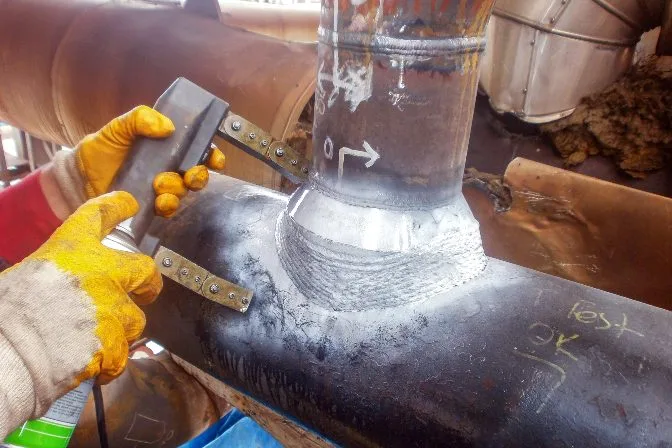Just How Tank Welding Inspection Prevents Future Structural Failures
Just How Tank Welding Inspection Prevents Future Structural Failures
Blog Article
A Thorough Summary of Tank Welding Evaluation Criteria and Methodologies for Improved Weld High Quality and Efficiency
The relevance of welding inspection criteria in the manufacturing of storage tanks can not be overstated, as they function as the backbone for guaranteeing weld integrity and functional reliability. Different examination strategies, consisting of visual analyses and advanced non-destructive screening approaches, are important in recognizing possible defects that could endanger efficiency. Additionally, sticking to regulatory standards not just enhances weld top quality but additionally alleviates the threat of costly failures. As we discover the subtleties of these methodologies, it comes to be critical to think about just how an organized strategy can change present practices and result in substantial improvements in end results.
Importance of Welding Evaluation Criteria

Welding inspection requirements incorporate a variety of criteria, including material specs, welding treatments, and credentials of workers associated with the welding procedure. By applying these criteria, companies can systematically determine and rectify prospective flaws, thus minimizing the probability of costly repair work or tragic failings. In addition, extensive inspection methods promote a culture of liability and precision, motivating welders to preserve high degrees of craftsmanship.

Common Welding Examination Methods


Ultrasonic Evaluating (UT) is an additional widespread strategy, utilizing high-frequency acoustic waves to find interior defects that may not be visible on the surface. This approach is especially reliable for determining spaces or inclusions within the weld steel. Magnetic Fragment Checking (MT) is likewise widely utilized, specifically for ferromagnetic materials, as it reveals surface area and near-surface issues through the application of electromagnetic fields and ferrous fragments.
Furthermore, Fluid Penetrant Testing (PT) spots surface-breaking defects by using a penetrant to the weld and afterwards making use of a designer to extract the penetrant. Each of these methods adds to a thorough assessment technique, making certain that welds fulfill the rigid quality standards needed in tank building.
Regulatory Specifications and Compliance
Regulative standards and conformity are necessary components in making sure the safety and security and integrity of bonded frameworks in container building and construction - Tank Welding Inspection. These standards offer to develop minimum demands for product homes, welding treatments, and evaluation techniques, thereby decreasing the risk of structural failings and enhancing general efficiency
Key organizations, such as the American Culture of Mechanical Designers (ASME) and the American Welding Society (AWS), offer standards that are extensively taken on in the industry. Compliance with these requirements not only guarantees adherence to best methods but likewise satisfies legal and legal obligations, guarding the rate of interests of stakeholders.
Governing bodies often mandate adherence to particular codes, such as ASME Code Section IX for welding certifications and API 650 for bonded storage tanks. These codes detail requirements for welding strategies, certifications of personnel, and screening approaches to confirm weld stability.
Routine audits and examinations are critical to keeping compliance, as they help identify inconsistencies from developed standards. Non-compliance can lead to considerable charges, task hold-ups, and security threats. Hence, a durable understanding of governing requirements and a dedication to compliance are paramount in accomplishing premium and long lasting welded tank frameworks.
Non-Destructive Testing Techniques
Exactly how can the honesty of bonded structures be assured without creating damage? Non-destructive screening (NDT) techniques offer a durable remedy, making it possible for inspectors to assess weld top quality without jeopardizing the product - Tank Welding Inspection. Amongst the most common NDT techniques are ultrasonic testing (UT), radiographic screening (RT), magnetic fragment screening (MT), and color penetrant testing (PT)
Radiographic screening entails passing X-rays or gamma rays with the weld, developing pictures that disclose structural defects such as fractures or gaps. This approach is invaluable for assessing the integrity of complicated welds.
Magnetic fragment testing is matched for ferromagnetic products, where electromagnetic fields disclose surface area and near-surface suspensions. Color penetrant screening utilizes a liquid dye to highlight surface-breaking flaws, making it an effective technique for non-porous materials.
Each of these NDT methods has unique benefits, allowing for thorough evaluations customized check over here to specific products and welding processes. By executing these techniques, industries can ensure the integrity and security of welded frameworks, eventually boosting overall efficiency.
Enhancing Weld Top Quality Via Examination
Reliable inspection plays an essential role in boosting weld top quality, functioning as an his response important checkpoint in the construction procedure. By recognizing possible flaws early, inspections reduce the threat of jeopardized structural stability and guarantee conformity with industry requirements. Utilizing a mix of aesthetic evaluations, non-destructive screening (NDT) approaches, and mechanical evaluations, examiners can discover problems such as porosity, cracks, and insufficient combination.
Implementing a robust assessment method not only improves the overall quality of welds but also promotes a society of responsibility among welders and makers. Normal training and qualification of assessment personnel guarantee that they are geared up with the needed skills to recognize and resolve possible issues effectively. This positive strategy minimizes rework and linked prices, ultimately adding to predict performance.
Additionally, thorough paperwork of evaluation searchings for supplies important insights right into reoccuring issues, facilitating continual enhancement in welding practices. By leveraging innovative innovations, such as automated ultrasonic screening or electronic helpful hints radiography, weld quality can be boosted via more accurate assessments. In final thought, an extensive examination procedure is vital in attaining high-quality welds, ensuring safety and security, reliability, and durability in tank fabrication.
Final Thought
In verdict, the execution of rigorous tank welding evaluation requirements and methods is essential for guaranteeing weld stability and efficiency. By making use of a combination of visual inspections, non-destructive testing approaches, and adherence to regulative standards, companies can effectively determine and mitigate prospective flaws.
Report this page